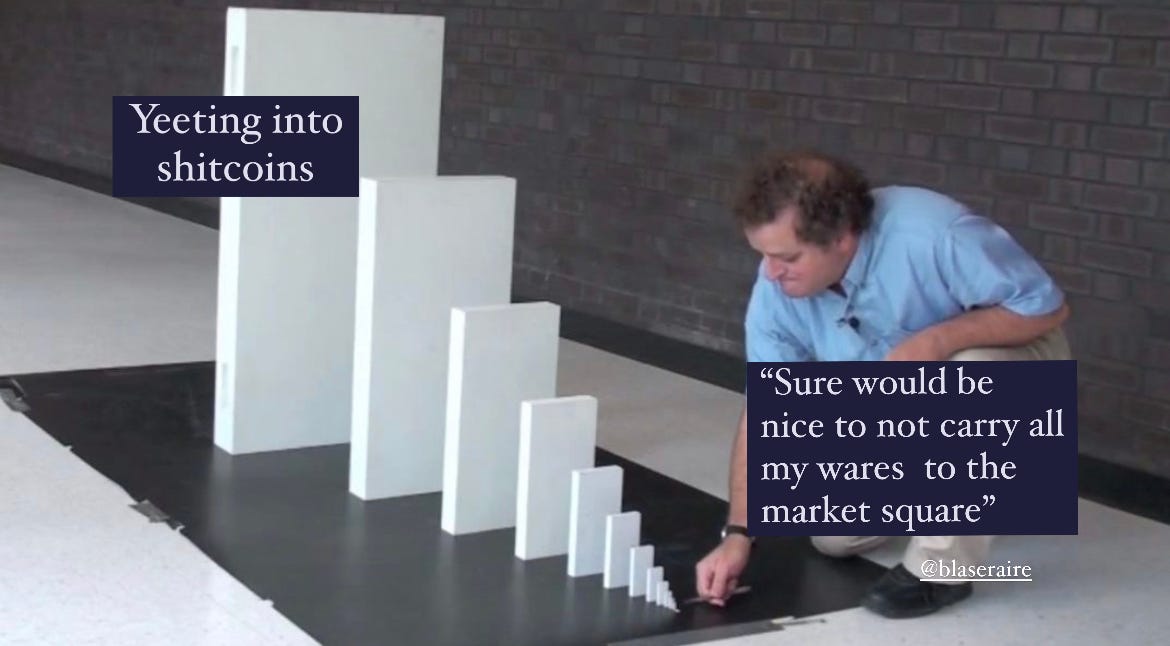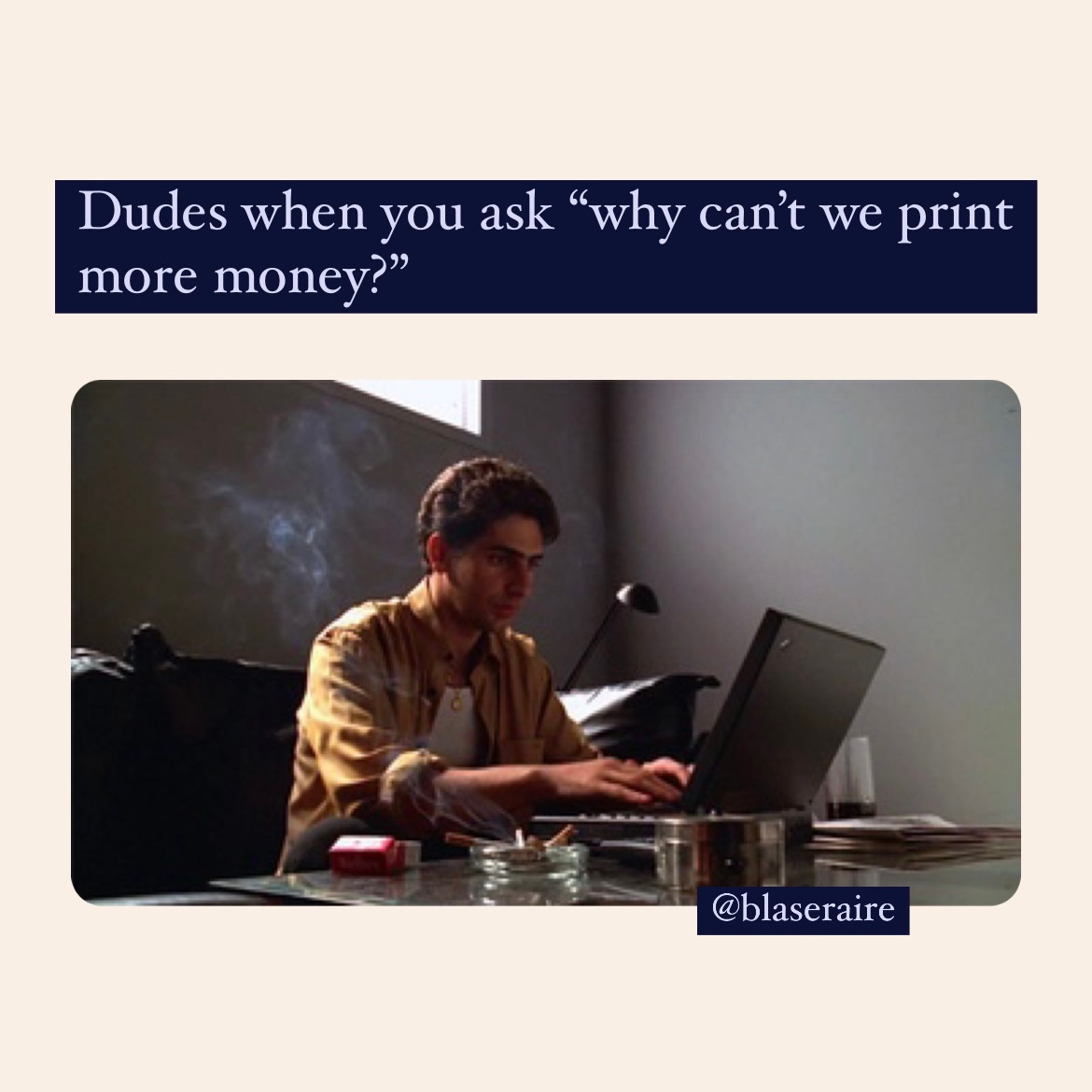The Myth of Money: Money Worship as a Belief System
Unit 3: Astrology & Money, Topic 2: Money Mythology
Hello Angel,
A quick note on how to engage with this article.
1. Like a class curriculum, each topic is part of a larger unit that dives into a distinct subject. Think of it like a vinyl record, each topic can be enjoyed as a track or fully experienced like an album. Subscribe to get them weekly in your inbox!
2. No knowledge gatekeeping here! We’re neophytes ourselves, presenting our laywomen’s research from topics that make us curious. If you see a bolded term, it is defined in the glossary at the end of this article.
3. Look out for underlined passages, these are your portal down the knowledge rabbit hole and lead to further reading. Insatiable? Original sources are merchandised on our interactive reference page at the end.
4. This is a *reciprocal* experience! We invite you to contemplate the discussion questions at the back. Or even cooler, forward the topic to a friend, colleague, or your crush and start a meaningful conversation.
Curiously,
Ambi & Abbey
Beliefs conjure up spirituality, myths and the ethereal; yet beliefs also constitute the scaffolding of our reality.
Unlike easily identifiable beliefs, like religion, money’s mythology has an omnipresence in our global economies that clouds objectivity toward it as a collective construct.
As Charles Eisenstein notes in Sacred Economics “We are devout to money. It is the invisible hand that sets our world in motion.”
How did we get here? Money was not always pieces of colorful paper. Exchange and gift societies, like that of Native people, allowed the flow of commerce through networks of exchange. While faint in our collective imaginations, there have been societies set up outside of today, and even outside of money itself.
Brief history of getting money
Money (a proxy for exchange) first appeared in China in the 11th century under the Shang dynasty.
Despite the donut-hole hollow center that enabled early shillings strung together for transport, it was cumbersome to tote around large quantities of metal discs.
Coins served as a fungible surrogate for goods for centuries; metal held inherent value, unlike paper. Along the Silk Road, precious metals held value for foreign exchange.
The uncoupling of value with money came with the advent of paper money, circa 600 BC. Paper money had a tech adaptation curve - it had no inherent use and was seemingly easy to dupe.
It wasn’t until ”counting houses” took off in 7th century China that paper money began to swim through commercial veins like a fish in the sea. It would take Europeans another 500 years to make it rain stacks.
And another five centuries before shares became proxies for paper money. In 1611, the Dutch parlayed their position as a mercantile epicenter to debut the first stock exchange. The first company to list? The infamous Dutch East India Company is known for its role in the spice trade but of course its more reprehensible role in the slave trade. If those nutmeg and power-crazed colonials were still at it today, the DEIC valuation would come in at a stroopwafel-spit take $7.2 trillion.
Sidebar: The Dutch East India Company “bought” Manhattan from the Lenape people for a handful of Venetian beads ($24 in today’s terms), the Lenape elders likely thought that the Dutch were simply presenting an offering to coexist in nature’s bounty. The Lenape people did not believe in ownership of nature and the commons. The concept of land ownership was not a part of their worldview…it was not a part of their belief system.
A century later, the first American exchange opened in the city of Brotherly Love. That masculine energy & “brotherhood” was a throughline of markets into the 1980s heyday, ypified by the archetypes of yuppie Wall Street a la Gordon Gecko, Jordan Belfort & Patrick Bateman.
Up until the 1980s, we had operated on the gold standard, but at that point, the amount of growth America desired outpaced the resources in the Federal Reserve.
In the past 40+ years, the growth we have been experiencing is backed by belief.
The thread here: Money is a mere symbol of value and conduit of exchange… perhaps even a conjuring of our imagination.
The Impact of the Money Mythology
Money is an emblem of value - not a resource itself. In gift economies, resource is exchanged for resource, in a money economy, value is exchanged for a conceptual symbol of value, making the value that money holds a subjective reality. Money has hollowed out all the valuable resources our planet & people have to offer.
Money rules the world and it doesn’t even need to be in the room; very few of us carry cash & transactions are digitally logged. The only other cultural omnipresence is God, but money seems to have more of a hand in our day-to-day.
Our conceptual understanding of value has been furthered by digital currencies and web-based commerce. The marketplace of ideas is one of the final resources we have to extort, as indicated by the success of social media.
With few more raw materials to commercialize, our likeness & attention are commodified to unicorn-levels of success online. It’s why startups with glossy branding are constantly trying to invent new needs to fuel consumer appetite…giving a whole new meaning to lipstick on a pig.
But we are running out of things to buy with our money and the misallocation of resources is becoming apparent. The hollowing of value explains why resource-rich countries of the global South are not as wealthy as the countries they export to.
Money tells us that it’s inevitable “some people” (almost 30% of the global population) go hungry while 2.5 billion tons of food is wasted annually. This is all because value has not been exchanged for value - only a symbol of value, a ghost of a resource.
While money infinitely compounds, untethered and unbacked, resources dwindle. Perhaps we can find more things to buy in outer space? Or in the deep sea?
Whether or not something is symbolic is irrelevant to its impact. Money may be a collective set of socially reinforced stories, but it still has very substantive ramifications.
It environs our collective day, from market open to close, the quest to exchange less money for more value continues. MoM, YoY, money is yielding more money, and having more money babies is the chief objective of most individuals and companies.
Bull or bear, it doesn’t matter if you’re getting the horns or running the charge, watching money tick up and down is wearisome on your mental health.
A recent study shows a market that volatility in the market (whether up or down) was stressful to investors. Whether you have it or you don’t, money fixation is bad for the psyche.
Getting money is a fixation for the haves as much as the have-nots. It’s why employee share of profit is at an all-time low as wages stagnate behind living costs to expand the bottom line for rich shareholders (more on that here). Increasing the bottom line is seen as an unequivocal good when money is the metric we measure success.
This tangible impact of the money myth on well-being proves that languages and symbols are powerful. Not only what they represent consciously, but how they inform our lives on a subconscious level. A profit motive tells us that growth for growth’s sake is an unequivocal positive. Others will say growth for growth’s sake is cancer.
Money is a powerful symbol that we all buy into and allow to feed our scarcity mindsets, rule our every day, and write the future for our civilization. Symbols are signifiers that help us make sense of the human condition. It’s why we ask “What’s your sign?” while flirting with someone new.
While some choose to navelgaze and count coins, others turn to the stargaze for purpose. Launch into outer space with Blase Raire and stay tuned as we explore another prolific belief, astrology.
Discussion Questions:
How does using proxies for money (e.g. credit cards) change the way we interact with it?
What would the world look like if we evaluated not just profit, but the implications of profiting holistically?
Are the best things in life free?
How does your perception of something change if you paid for it? Got it for free? Were gifted it from someone you know?
What do you think are the beliefs about money that guide our society?
Glossary:
Mythology: in a general sense, refers to a collection of traditional stories or legends that are passed down through generations within a culture or society.
Money: a symbol that represents value and is used to exchange goods and services. It's like a tool we use to trade things we want or need.
Fungible: Fungible means that something can be easily replaced or exchanged with something else of the same kind. For example, money is fungible because you can exchange one dollar bill for another dollar bill, and they have the same value.
Proxy: A proxy is something that represents or stands in for something else. In the context of money, a proxy can be a form of currency that represents a certain value, like a paper bill or a digital transaction.
Stock exchange: A stock exchange is a marketplace where shares of publicly traded companies are bought and sold. It's a place where investors can trade stocks and other financial securities.
Gold Standard: The gold standard is a monetary system in which the value of a currency is directly linked to a specific amount of gold. Under the gold standard, each unit of currency is convertible into a fixed amount of gold. This means that the value of the currency is determined by the supply and demand for gold in the international market. The gold standard was widely used in the 19th and early 20th centuries, providing stability and confidence in the value of currencies. However, it was gradually abandoned by countries in the mid-20th century due to various economic and political factors.
Symbol: A sign or indicator that represents something else. It can be a gesture, a word, or a visual symbol that conveys meaning.
Signifier: A signifier is the physical form or representation of a sign. It's the actual object or image that we associate with a particular meaning or concept. This dictates the significance of a particular symbol.
Unicorn: A privately held company worth over $1 billion.
Sources:
A Brief History of the Stock Market - 1611
Food Security Update | World Bank Response to Rising Food Insecurity - The World Bank
Was Manhattan really sold for $24 of trinkets and beads?






